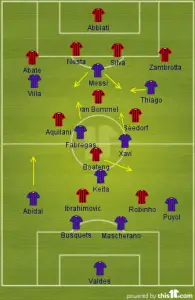Barcelona overcame Milan at the San Siro in a match which differed markedly from the 2-2 draw between the teams in September. In that encounter, Milan scored early on and ‘parked the bus’ before conceding two goals, then snatching an equaliser in the dying seconds. They attempted to be more proactive in front of their home crowd, but this played into the Catalans’ hands.
The teams set out as usual; Milan in a 4-3-1-2 and Barcelona in their well-known 4-3-3. Max Allegri left out captain Massimo Ambrosini in favour of Alberto Aquilani, as if to signal a more positive intent. Barcelona were missing Dani Alves and Gerard Piqué was only deemed fit enough for the bench so Mascherano and Busquets played at centre-back, with Puyol moving out to the right of defence and Keita filling the holding midfield slot. Thiago Alcântara played narrow on the right of attack.
First half: faltering defences lead to a lot of chances
Milan came out of the blocks strongly, attacking the away side and pressing intently. But this rather resembled Manchester United’s start to the Champions league final as Barcelona soon found their stride, taking control for the majority of the game (they finished with 59% possession). Milan’s narrow midfield had its usual problem of dealing with fullbacks motoring forward; as there was nobody to oppose Eric Abidal, he was a very easy out-ball.
As for Milan’s fullbacks, they were having a tough time defensively. Both switched off for the first goal; Zambrotta letting Thiago beat him to a ball which he had no right to win, before Abate failed to see Keita ghost into the far post, the Malian’s ball deflecting off van Bommel for an own goal. The tricky Thiago was giving Zambrotta a hard time, again getting the better of him to set up a good chance for Messi.
Milan’s midfield wasn’t doing a much better job. Despite van Bommel’s attention, Messi was finding space between the lines and was given options by the onrushing Xavi and Fabregas. This was a result of Allegri’s decision to place two playmakers ahead of van Bommel. While this was commendable for positive intent, a ‘runner’ such as Ambrosini or Nocerino could have done better at tracking Barça’s central midfielders. Van Bommel could even have dropped deeper to try to restrict Messi’s space in front of the Milan defence (see the space between him and the centre-backs in the average positions below).
To be fair to Milan, they carried an attacking threat of their own. While Barcelona’s pressing makes it hard to pass through them (especially with all of Milan’s midfield being in the middle), they found some joy with Aquilani playing diagonal balls to the left, giving Boateng or Robinho a one-on-one with Puyol and the opportunity to pass into the box. That was the buildup for Ibrahimovic’s equaliser
This was aided by Barcelona’s own defensive troubles; playing two defensive midfielders in central defence works well when they dominate, as those players play in their usual zone (around the halfway line). However, they seemed unsettled when Milan came at them and at times struggled with positioning. This was exploited in the previous encounter by Pato’s pace; this time round, Ibrahimovic was to profit. First, his ability to hold the ball up led to a chance that Robinho should have converted. Minutes later, he had made it 1-1. Poor positioning and loose marking from Mascherano and Busquets was evident on both occasions.
Still, Barcelona kept attacking and the lack of tracking from Milan’s midfield cost them. Xavi got on the end of a Messi through-ball and while Nesta may not have actually fouled him, they deserved to retake the lead from Messi’s penalty.
Second half: Milan pull it back but don’t learn from mistakes
Pato came on for Robinho at half-time, with Allegri maybe casting his mind back to Busquets and Mascherano’s struggles with his explosive pace a couple of months ago. He failed to provide the same threat as Barcelona were not losing this time, so there was less need for the centre-backs to push up so much. But he still managed to take advantage of their penalty-box uncertainty; winning his header against Busquets (who stands almost 4 inches above Pato), before Mascherano headed the ball to Boateng for another equaliser resulting from direct play.
However, Milan also failed to learn from their mistakes. While their play with the ball was improving, they were still looking vulnerable when Messi ran at them. Inevitably, another through ball found its way to Xavi, who finished superbly.
After an exciting hour, the game started to peter out as Milan searched for an equaliser in vain. Their midfield shape is more suited to counter-attacking or controlling the middle rather than chasing a goal, although long balls to Ibrahimovic looked like they might bring some joy. Nocerino, who could have been on earlier for defensive reasons, was instead brought on for van Bommel to give the midfield some thrust (with Seedorf becoming a deep-lying playmaker in front of the defence). Still, they could not create more clear chances against Barcelona, who did a good job of stopping the supply from deep by bringing on Pedro and Sanchez for Villa and Fabregas to close down from the front; a prime example being Sanchez superbly chasing back to stop Aquilani playing the ball forward in the 87th minute.
Barcelona attacked superbly and will be delighted to have won in the San Siro but this match showed that with both Busquets and Mascherano in central defence, they can be unsettled by direct play. They will be keen to have at least one of their ‘natural’ centre-backs playing in the later stages. As for Milan, they competed well enough against top-class opposition and showed that they have the attacking talent to trouble anyone, but getting outplayed at home brings up the limitations of Allegri’s narrow midfield and suggests that they’re outsiders in the Champions League this year.
–Ihsaan Budaly











Recent Comments